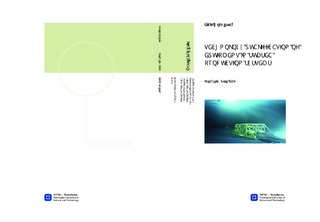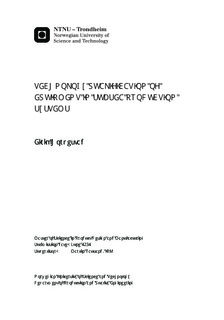| dc.description.abstract | Development of new technology has always been an important activity for the oil and gas in- dustry. New technologies can streamline the production, improve the recovery rate and provide economic benefits. The implementation cost may be regarded as high, but the end result may totally easily turn out to have great economical advantages. The challenge is that new technology usually involves potential threats with high uncer- tainty. These factors must be managed prior to implementation. This is achieved through tech- nology qualification. The aim of technology qualification, is to provide sufficient evidence that the technology is fit for purpose. The master thesis begins to describe relevant key terms, qualification, verification and vali- dation. Each of these are discussed and compared which increases the understanding of quali- fication. In addition, different qualification methods are introduce and discussed. The methods describe how the qualification evidence is provided, through physical testing, analytical evalu- ation, or a combination as integrated qualification. An in-depth literature survey is introduced, where relevant qualification standards, recom- mendations and other governing documents are presented. General qualification documents provide guidance of how a general qualification should be executed in a project. Business- specific documents illustrate how the general documents are implemented into the business- specific procedures, as well as own guidance. Guidance for qualification of safety instrumented systems, and supplementary qualification documents are also mentioned. Some of the documents introduce technology qualification program and technology qualifi- cation process. A technology qualification program is the framework of how a technology qual- ification process should be executed. The process deals with a structured set off steps, intended to reduce threats, predict future outcomes, and provide evidence in order to determine whether the qualification requirements are met or not. A more detailed description of the qualification process presented by DNV-RP-A203 is provided. This process represents the recent and most up to date version of qualification, and is today considered as state of the art by the oil industry. The process includes six steps, that are, technology qualification basis, technology assessment, threat assessment, technology qualification plan, execution of the plan, and performance assessment. Companies that develop technology, needs guidelines for qualification. The thesis describes how and which documents that should be followed through the qualification, and identifies possible challenges, in more specific Aker Solutions and Statoil procedures. At the end of the thesis, a extensive qualification case study is documented based on the technology qualification process provided in DNV-RP-A203. A passive subsea inlet cooler unit is selected as case equipment. Such subsea technology are adopted from existing topside solu- tions, but modified to withstand other hostile operational and environmental conditions. Quali- fication requirements for the inlet cooler unit are identified in the technology qualification basis. The maturity of the unit is defined in the technology assessment, and critical failures found in the threat assessment. A qualification plan is developed with four different activities intended to reduce the critical failures. The plan is executed, and the performance assessment consid- ers to what extent the qualification requirements are met. Due to insufficient material, the last process step is inadequately reached. In addition, an extension of the case study is carried out in terms of a productions assur- ance analysis. The analysis is conducted using MIRIAM Regina, where a model is modulated with respect to failure modes identified in the threat assessment. Each failure mode is assigned different parameters, like failure rates and restoration time. The model is validated by com- petent staff at Aker Solutions. The simulation is carrier out with 25-year perspective, through 1000 replications. The simulated results shows that the average technical availability for the in- let cooler unit is 98,93%. Due to no availability requirement stated for the inlet cooler unit, the thesis does not draw any qualification conclusions. However, it indicates that, if this simulated value is higher than required availability, and additional requirements are met, then the inlet cooler unit is considered as qualified. | nb_NO |

